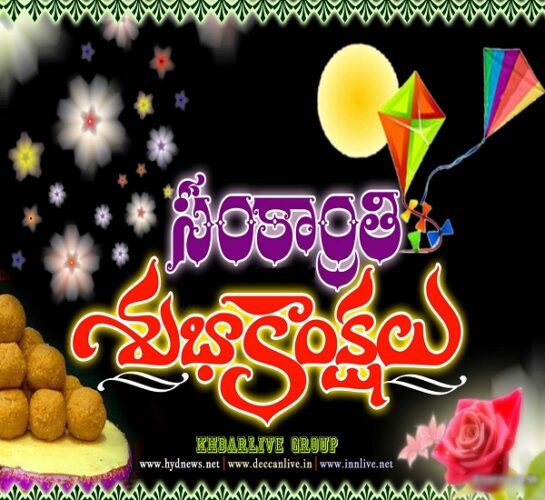Streets are full of rangolis, decorated bulls and Haridasulu – Sankranti, the colourful Telugu harvest festival, was celebrated with gaiety and traditional fervour across the city on Friday. Streets and surrounding colonies wore a festive look with colourful kites, rangolis, decorated bulls and rang with the songs of Haridasulu.
Bhogi, the first day of the three-day festival began with citizens lighting bonfires. Bhogi fires were seen on almost all the streets in the city. The old and worn out household items like used up brooms, winnow and other flammable articles were consigned to the flames as per the tradition.
In some junctions huge logs were put on the road to make the bonfire. Vessels of water were put on the burning embers after the flames died down. The water heated in this manner is used to have a head bath to wash away the bad luck of the year that passed.
Empire Circus which has been in the city for the last few days celebrated the festival highlighting the traditional values and costumes of the Telugu people.
Acrobats from Armenia, Tanzania and other African nations wore Telugu traditional attire to celebrate the festival.
The acrobats fed the dancing bulls with typical items from Andhra cuisine. ‘Arisalu, karapoosa and raw rice was fed to the bulls that consumed the items with relish. The acrobats then watched in awe the circus of sorts performed by the dancing bulls and their masters.
‘Haridasus’ and ‘Basvannas’ attired in their traditional best went around the streets giving performances and singing songs for the small offering made to them by citizens.
The festival was also celebrated in a big way at the Vijayawada Club where members gathered for a Bhogi bonfire. Haridasulu sang and Gangireddulollu gave performances. Children flew kites and enjoyed crunching sugarcane that is becoming difficult to procure.
As we go deep into the significance and history, Makar Sankranti is the festival of kites, sweets made of sesame and the arrival of spring. The festival is dedicated to the Sun God and is a marker for new beginnings.
Makar Sankranti is the festival of kites, sweets made of sesame and the arrival of spring. After months of gruelling winter, Makar Sankranti marks the day when Sun transmigrates from its zodiac and moves northwards from Tropic of Cancer to the tropic of Capricorn. Makar Sankranti is a harvest festival in India, it is called by many names across the country.
Its called Thai Pongal in Tamil Nadu, Uttarayan in Gujarat, Maghi in Haryana, Himachal Pradesh and Punjab and Bhogali Bihu in Assam. This year the festival will be celebrated on January 14.
People fly kites in the mornings and take a dip in holy rivers like Ganga and Yamuna. It is a ritual which is believed to wash away sins. In Gujarat people start manufacturing kites in large numbers a month before Sankranti. Melas are a must during Makar Sankranti and the most famous one being the Kumbh Mela.
Though Kumbh Mela is held in many places occasionally but it supposed to be held every 12 years in Haridwar, Prayag (Allahabad), Ujjain and Nashik. It is called the Magha Mela or mini-Kumbh Mela in Prayag), Makara Mela in Odisha and Tusu Mela in parts of Jharkhand and West Bengal.
The festival is dedicated to the Sun God and is a marker for new beginnings. As the sun takes a new journey and when winter begins to turn towards summer according to Hindu Calendar. In Hindu epics it is called the Uttaarayan. In Mahabharata, Bhishma Pitamah waited for the sun to be in Uttarayan for him to die peacefully.
On Makar Sankranti, people traditionally share and eat sweets and laddoos made of sesame (til) and jaggery (gur) that helps in keeping our body warm during the still chilly weather. Another custom is kite flying, which is both fun and beneficial for health, as it allows us to stay in the sun.
Kite flying also has symbolic meaning in Indian culture. It is also said that the higher your kite goes, the higher you will rise in life. Adding to the fun factor is the kite flying competitions. This is all about cutting other people’s kite strings while saving your own kite and making sure it soars high in the sky. #KhabarLive







